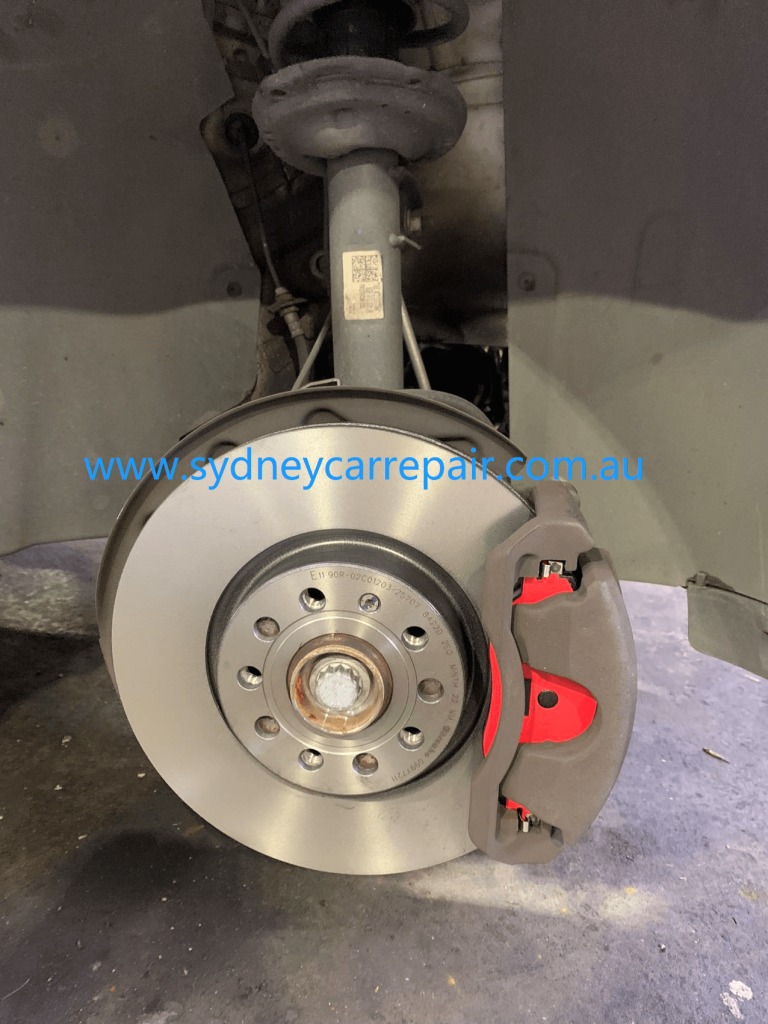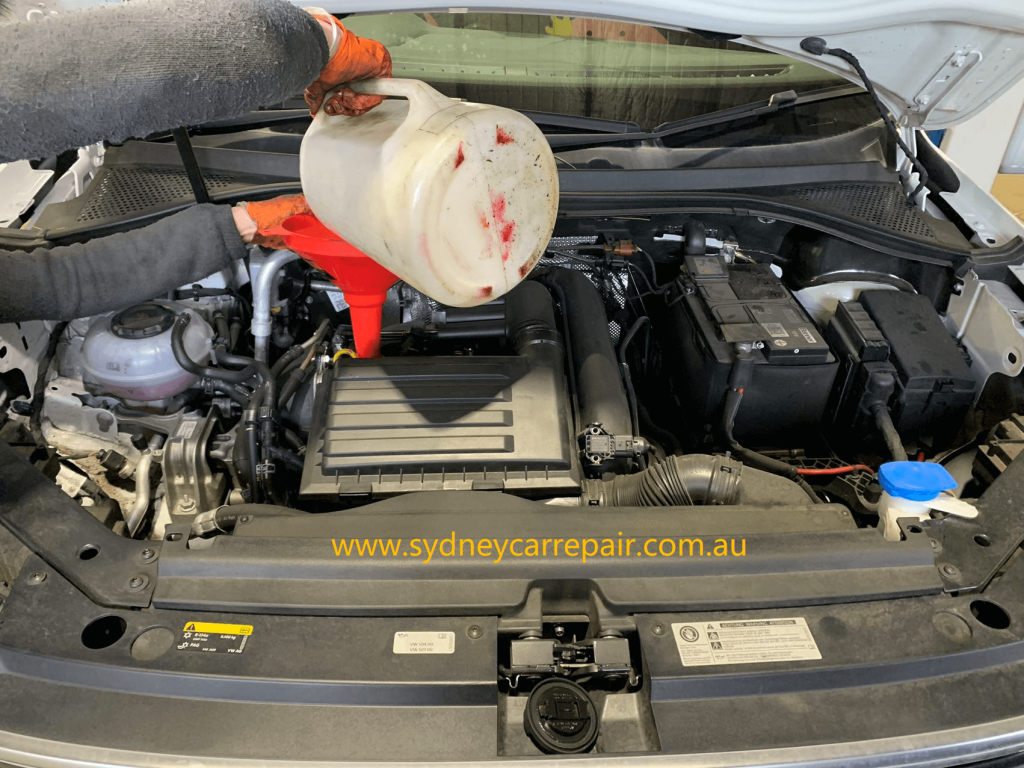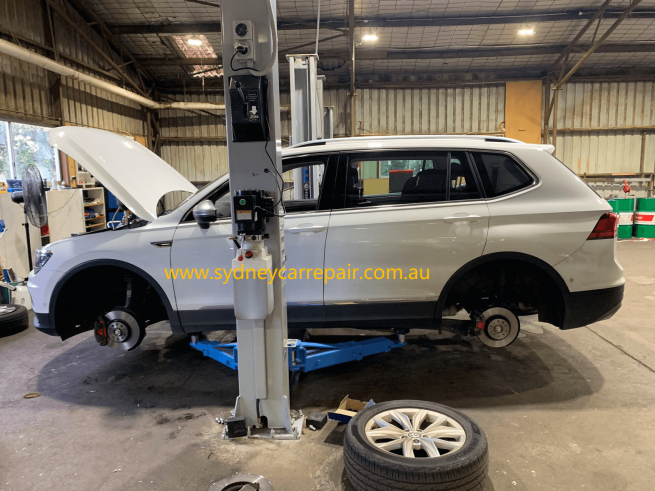What is a front brake pad and rotor?
The brake pads and disc rotors fitted to most modern day vehicles make up the wear and tear items of the braking system. The brake pads are made up of a metallic friction composition, which is bonded to a metal backing plate.
Speed limits mean it doesn’t really matter how fast your car can go or how quickly it can get there. However, stopping is another matter. The braking system is the critical to the safety of your vehicle, yourself and your passengers.
Over time brake rotors wear out. They may crack or develop deep score marks, warp or simply wear out. When this happens they need to be replaced.
Why it is important to replace your brake pads and rotors?
Having your brake pads and disc rotors replaced when they are worn out will ensure that your braking system is in good condition, and will bring you to a stop safely and reliably when you press down on the brake pedal.
Driving a vehicle with excessively worn brake pads and disc rotors may reduce the effectiveness of the braking system and put you and other motorists in danger.
Material and Tools
Materials
- Replacement Brake Rotors
- Lubricant, WD40, Inox etc
- Tie Wire
Tools
- Vehicle Jack
- Car Stands
- Spanner Set
- Socket Set
- Screwdriver
- Wire brush or oil stone
How to Replace Brake Pads and Rotors
- SAFETY FIRST
Park the vehicle on a dry, flat surface and install wheel chocks. Be sure to wear safety goggles and protective gloves. Be careful when lifting the car. Use secure jack points for the jack and jack stands.
- CHECK THE BRAKE FLUID LEVEL
Open the hood and check the brake fluid reservoir. If it’s full, some fluid needs to be removed. This will help avoid spillage due to overflow when compressing the brake caliper piston.
- RAISE THE VEHICLE AND REMOVE THE WHEEL
Loosen the lug nuts with a breaker bar and socket while the wheel is on the ground and stationary. Raise the vehicle with a hydraulic jack from a secure point. Place a jack stand or stands under the appropriate points and safely lower the vehicle onto the jack stands. Remove the lug nuts and the wheel.
- REMOVE THE BOLTS AND THE CALIPER
You should be able to reach the caliper bolts pretty easily. Turning the wheel left or right will provide easier access. Once the caliper is removed, suspend it with a bungee cord. Note: Removing the caliper may require different steps on your vehicle.
- REMOVE THE OLD PADS AND ROTOR
Inspect the old pads for uneven wear patterns. Uneven wear is an indicator of the pad or pads ‘sticking’ due to lack of lubricant, worn pad or caliper hardware, or a sticking caliper piston. The brake pad box will have a guide to reference when inspecting for uneven wear.
Once the pads are off, remove the rotor. On many vehicles, you’ll need to remove the caliper mounting bracket in order to remove the rotor. The brake caliper bolts to the brake caliper mounting bracket which bolts to the spindle assembly. To remove the brake rotor, first remove the brake caliper and then remove the brake caliper bracket. This will allow access to the rotor.
When removing the rotor, watch out for rust or uneven wear. You may need help from a rust penetrant like PB B’laster or a mallet to finish removing it from the hub assembly.
- CLEAN THE ROTOR MOUNTING SURFACE
The hub surface needs to be cleaned with a wire brush to remove rust and debris. This will ensure the new rotor sits flush on the hub and eliminates the possibility of pedal pulsation. Rust as thin as a sheet of paper can translate to pedal pulsation.
- CLEAN THE NEW ROTOR
Grab some AutoZone Brake Cleaner. Duralast Gold Rotors come with a rust fighting protection coating, so you can skip this step if you’ve got those.
- INSTALL THE NEW ROTOR
Look at you. You’re doing great.
- INSTALL BRAKE HARDWARE
Replace the brake hardware with new hardware. When worn, old brake hardware creates vibrations that is heard in the form of brake noise at low stopping speeds. These clips should be replaced with each brake job. Make sure to apply brake lubricant at the slider contact points before installing the hardware.
- GET BRAKE PADS READY TO INSTALL
Note the wear-sensor position orientation to install the pads correctly. Different pads have varying wear-sensor placement. Some pad sets have wear sensors on just the inner pads, some on all four pads, and some do not have wear sensors.
- INSTALL NEW BRAKE PADS
Looking good over here!
- INSPECT BRAKE CALIPER AND PISTON, THEN COMPRESS
Look at the brake caliper and piston and inspect it for any brake fluid seepage. If the caliper and piston are clean, use the front/rear disc brake pad spreader set to safely seat the caliper piston. You can borrow the spreader set for free from any AutoZone through Loan-A-Tool.* On some rear disc brakes, the caliper pistons screw in, and require the disc brake pad spreader set to be seated properly.
- INSTALL THE CALIPER
Take the caliper off the bungee cord and put it back on. VERY IMPORTANT – DO NOT OVERTIGHTEN the caliper bolts. This can lead to much bigger problems. Start tightening the bolts with a socket, then use a torque wrench to tighten the bolts correctly. You can borrow a torque wrench for free at any AutoZone through Loan-A-Tool. Consult a service manual for proper torque specs.
- CHECK BRAKE FLUID RESERVOIR
Top-off to the max fill line if needed. Be sure the brake fluid reservoir cap is installed before going to the next step. This will avoid spillage.
- PUMP THE BRAKES
This will make sure brake fluid is flowing properly and the system is working. Sit in the vehicle and slowly pump the brake pedal until it feels firm. CAUTION Do NOT press the brake pedal all the way to the floor. This may cause internal damage to the brake master cylinder assembly.
- CHECK THE BRAKE FLUID RESERVOIR AGAIN
Top-off again if necessary. Always re-install the cap after topping off to avoid spillage.
- INSTALL THE WHEEL AND LOWER THE VEHICLE
Install the wheel and tighten the lug nuts while the vehicle is raised. Raise the vehicle with a jack, remove the jack stands, lower the vehicle until the wheel is just touching, and tighten the lug nuts with a torque wrench. Consult your owner’s manual for the proper torque for your vehicle.
- REPEAT ON THE REMAINING WHEELS
Make sure the brake pedal is firm before driving.
- GO FOR AN EASY DRIVE
Go for a safe, easy drive to break in the new brakes. On a safe road, accelerate to around 50mph. Apply the brakes, not too hard, and slowly bring the vehicle’s speed down to 30mph. Continue to drive at this speed for 2 to 3 minutes to allow the brakes to cool. Repeat this process four to five times until the new brakes are ready for daily use. This process is known as bedding brakes.
How much does a front brake pad and rotor replacement cost?
The front brakes on your vehicle are the ones that do all the work.
They are responsible for about 70% of the stopping force produced by the braking system, and as such, they cop quite a beating.
When you press down on the brake pedal, the brake pads are forced into the brake disc rotors (the big shiny round things behind your wheels) to slow your vehicle down. The friction material of the brake pads wears down over time, and can also wear out the disc rotors, and they need to be replaced to ensure correct operation and reliable brake performance.
The average cost of having your front brake pads and disc rotors replaced starts around $300 and can increase to $700+, depending on the type of vehicle and the brake components used.
Looking for Car Repair and Car Inspection in Sydney? Give us (Sydney Car Repair) a call today to get FREE QUOTE.


All of our car servicing and car repair jobs are carried out by licenced vehicle technicians with years of extensive experience across all popular and luxury makes and models.
Our Address: 71 Atkins Road, Ermington, NSW 2115

Turn on Your Camera and Scan Me to add our contact detail to your phone.
If you are live in Eastwood, Carlingford, Ermington, and you need to have your car service and repair near me, car maintenance near me, car mechanic near me sydney you are welcome to visit our car mechanic shop to get it done. We do car servicing and car repair job for people for the Eastwood, Carlingford, Epping, Ryde, Ermington, and all the rest of Sydney, Australia. Mechanic near me car, repair near me, vehicle repair near me. Tyre repair near me, tyre replacement near me.
If you need mechanic near me or car repair or used car inspection near me, we can repair most of the following car’s and repair for you in sydney: TOYOTA, HONDA, BMW, BENZ, MINI, NISSAN, Mitsubishi, Subaru, Audi, Volkswagen, Hyundai, Ford, Holden, JEEP, tesla and many more。


